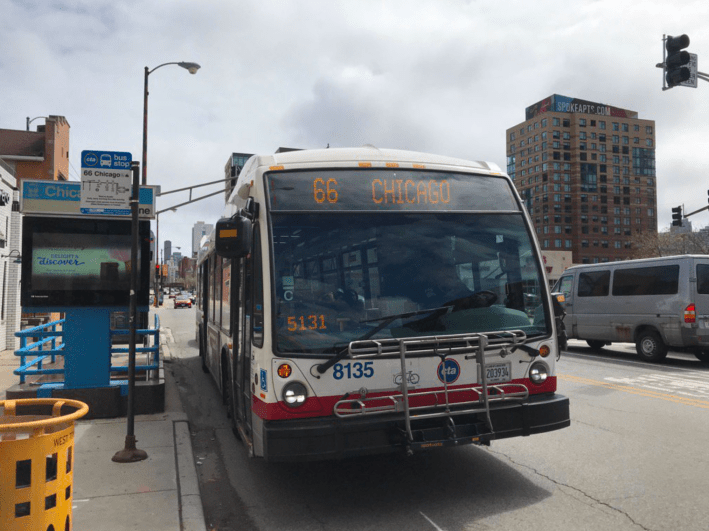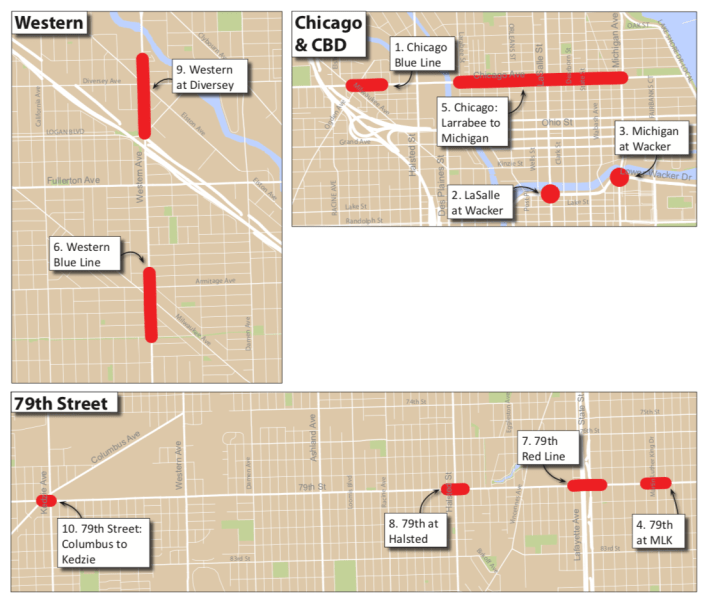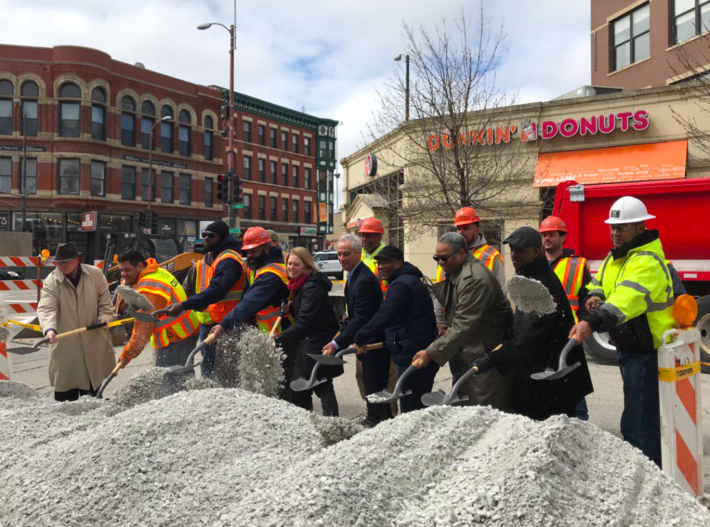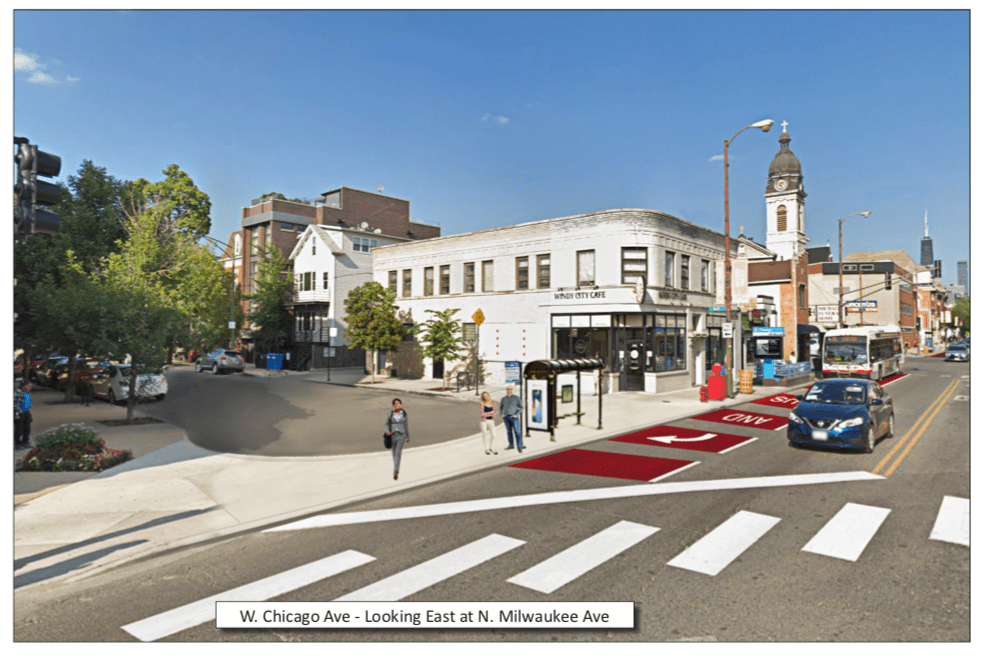Today Chicago took a step to address our city's slow bus speeds and pathetic bus lane mileage -- a mere 4.1 miles of dedicate lanes versus 35.4 miles in Los Angeles and 82.8 miles in New York City. City officials announced plans for short stretches of red bus-only lanes on Chicago Avenue, Western Avenue, and 79th Street, plus other improvements to speed bus service and improve pedestrian safety.
The $5 million Bus Priority Zones project focuses on unclogging bus slow zones at bottlenecks and pinch points, with the goal of improving service along entire bus routes. This initiative coincides with Chicago's developing policy of allowing dense, parking-lite transit oriented-development policy along high-capacity bus corridors, and is one of the first projects to be implemented based on recommendations made by the city's Transportation and Mobility Task Force in March.
In addition to the new bus lanes, which may be in effect all day or only during designated periods, other timesaving features will include queue jump signals to give buses a head start at intersections, relocating bus stops for maximum efficiency, and pedestrian safety infrastructure.

The first project focuses on chaotic Chicago/Milwaukee/Ogden junction, home to the Chicago Avenue Blue Line station. It's one of the busiest bus-boarding locations in Chicago during rush hours, and the #66 Chicago Avenue bus, with 6.9 million rides taken in 2017, is one of the highest ridership and highest frequency bus routes in the CTA system.
The eight-week project, which kicked off today, include street repaving, new signs and the cul-de-sac-ing of May Street north of Chicago to simplify the intersection and provide a longer bus boarding area for riders. Along with a short stretch of bus lanes on Chicago Avenue between Sangamon and May streets, a one-mile stretch of bus lanes will be installed on Chicago downtown between Larrabee Street and Michigan Avenue.
The #79 79th Street bus route, with 7.8 million rides in 2017, will also be getting improvements at the Kedzie Street, Halsted Street, Dan Ryan Expressway, and King Drive intersections.
Western Avenue will get bus lanes between George Street and Logan Boulevard, as well as between McClean Avenue and Moffat Street. Transit signal priority, which shortens red lights and extends greens to help keep buses moving, is slated to be completed on Western by the end of this year.
Improvements will also be made downtown on Wacker Drive at LaSalle Street and Michigan.

At a groundbreaking for the May Street project this morning, CTA President Dorval Carter Jr. listed other bus projects the city has completed under Mayor Rahm Emanuel, such as the downtown Loop Link express bus corridor, the (stalled) effort to build bus rapid transit on Ashland Avenue, rush-hour bus lanes on the Jeffery Jump route, and prepaid boarding for westbound bus customers from the Belmont Blue Line station. He added that the CTA has updated its buses under Emanuel and currently has one of the youngest fleets in the country.
Emanuel noted that Chicago bus ridership has dropped in recent years. Studies have shown that the rise of ride-hailing, and the ensuing increase in traffic congestion, which slows down buses, are to blame for this decrease. "This investment is about moving the buses faster so they can continue to be a competitive transportation mode," he said.
Of course, bus lanes aren't as effective for speeding up service if private vehicle drivers use them, which is why Loop Link has resulted in only modest bus trip time improvements. Camera enforcement of bus lanes, which is currently done in cities like New York, would require new legislation in Springfield. Chicago mayor-elect Lori Lightfoot plans to "work with the state legislature to permit fair camera enforcement of bus lanes,” according to a statement from a spokesperson last month.

Rebekah Scheinfeld, commissioner of the Chicago Department of Transportation, which is building the new bus infrastructure said that having more miles of bus lanes will naturally lead to better compliance from motorists. "There's a big benefit to continuing to socialize bus lanes throughout the city," she said. However, she added that "having more automated enforcement options would be very effective, and it would allow police to focus on things related to violence." She added that the revenue from the tickets could be used to support bus operations.
Ron Burke, director of the Active Transportation Alliance, which has promoted better bus service through initiatives like its "Back on the Bus" study and bus report card project, lauded the new bus improvements, but he agreed that camera enforcement is needed to maximize the benefits of the bus lanes. "Unfortunately, automated enforcement is a bit of a lightning rod issue in Springfield," he said. "My hope is that a bill that narrowly limits video enforcement to bus lanes, maybe with cameras on the buses [as is done in other cities] might quell the concerns of some legislators."
Burke added that Active Trans would support steps to help ensure that tickets for driving in bus lanes don't result in a financial burden for low-income residents, such as sliding-scale fines, or allowing violators to take a safety class in lieu of paying a ticket.





